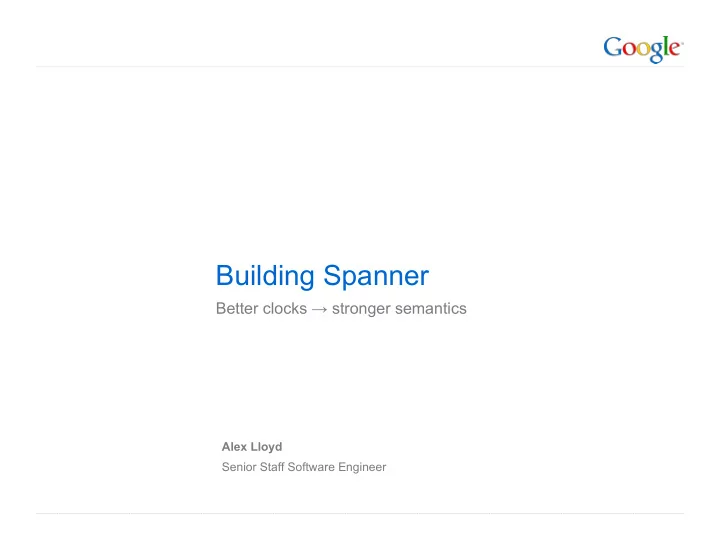

Building Spanner Better clocks → stronger semantics Alex Lloyd Senior Staff Software Engineer
How to build a planet-scale serializable database Build clocks with bounded absolute error, and integrate them with timestamp assignment: • Ensure timestamp total order respects transaction partial order • Offer efficient serializable queries over everything
Spanner • Descendant of Bigtable, successor to Megastore • Scalable, global, Paxos-replicated SQL database • Geographic partitioning Fluid: online data moves Hidden: no effect on semantics
Spanner: why? Goal: building rich apps easy at Google scale Megastore experience • Replicated ACID transactions • Performance, lack of query language, rigid partitioning Bigtable experience • Scalability, throughput • Eventual consistency difficult with cross-entity invariants
Spanner: data model (simplified)
Spanner: physical representation Customer.ID.1.Name@11 → Alice Customer.ID.1.Name@10 → Alize Customer.ID.1.Region@10 → US Customer.ID.1.Order.ID.100.Product@20 → Camera Customer.ID.2.Name@5 → Bob
Spanner: concurrency Default: serializability • Strict two-phase locking for read-modify-write transactions Big performance hit (two-phase commit) if spans partitions • Snapshot isolation (no locks) for read-only transactions Small performance hit (timestamp negotiation) if spans partitions Opt-in: serialize read in the past • Consistent MapReduce over all data • Boundedly-stale reads (useful at lagging replicas)
What guarantees do we want? … coming up: how we get them at reasonable cost.
Preserving commit order: example schema
Preserving commit order
Snapshot MapReduce and queries Initial state T1@ts1 INSERT INTO ads VALUES (2, “elkhound puppies”) T2@ts2 INSERT INTO impressions VALUES (US, 2PM, 2)
Legal transaction orderings
Linearizability (multiprocessing term) Equivalent to some serial order Can't commute commit order: system preserves happens-before relationship among transactions • even when there's no detectable dependency • even across machines
Options for Scaling Lots of WAN communication • Include all partitions in every transaction • Centralized timestamp oracle No extra communication • Propagate timestamp through every external system & protocol (Lamport clocks) • Distributed timestamp oracle
Options for Scaling Lots of WAN communication • Include all partitions in every transaction • Centralized timestamp oracle No extra communication • Propagate timestamp through every external system & protocol (Lamport clocks) • Distributed timestamp oracle TrueTime: now() = {time, epsilon} derived from GPS, backed up by atomic oscillators
What guarantees do we want, … and how we get them.
Celestial navigation
TrueTime
TrueTime
TrueTime: Marzullo's algorithm (also used in NTP)
TrueTime → write timestamps • Given write transactions A and B, if A happens-before B, then timestamp(A) < timestamp(B) even if A and B have no partitions in common. • A happens-before B if its effects become visible before B begins, in real time. Visible means acked to client, or updates applied at some replica. Begins means first request arrived at Spanner server. • Ensures serializability of future snapshot reads at arbitrary timestamps.
TrueTime → write timestamps
Why this works
When this costs something
TrueTime epsilon Sawtooth function from 1-7ms in existing system Slope: oscillator error assumptions Minimum: latency to time masters
Reducing TrueTime epsilon Poll time masters more often (currently every 30s) Poll at high QoS • Must enforce even in kernel Record timestamps in NIC driver Buy better oscillators … and watch out for kernel bugs!
•Spanner: distributed database •Concurrency properties: linearizability •TrueTime: GPS and atomic oscillators •TrueTime intervals → write timestamps • So how do we read?
Kinds of read • Within read-modify-write Acquire locks in lock manager at Paxos leader(s) • “Strong” reads Spanner picks timestamp, reads at timestamp • Boundedly-stale reads Spanner picks largest committed timestamp, within staleness bounds • MapReduce / batch read Client picks timestamp
Timestamps for strong read Using TrueTime • timestamp = now().max Using commit history • Remember commit timestamps from recent writes • Must declare “scope” up front trivial for stand-alone queries or, “orders from user alloyd” • Complicated by prepared distributed transactions
Principles for effective use Still design schema for data locality • Example: try to put customer and orders in same partition; big users span partitions Design app for correctness Relax semantics for carefully audited high-traffic queries
First big user: F1 Migrated revenue-critical sharded MySQL instance to Spanner Substantial influence on Spanner data model Slides from SIGMOD 2012 talk online
Evolution of data model 1. Distributed filesystem metaphor; directory was unit of geographic placement 2. Added structured keys to directory and filenames 3. Made Spanner a hierarchical “store for protocol buffers” (Meanwhile, started work on SQL engine) 4. Watched F1 build relational schemas atop Spanner → moved to a relational data model
Examples of ongoing work Polishing SQL engine • Restartable SQL queries across server versions (!) Hardening • Finer control over memory usage • Finer-grained CPU scheduling SI-based “strong” reads Scaling to large numbers of replicas per Paxos group (partition)
Thanks! Questions?
Recommend
More recommend